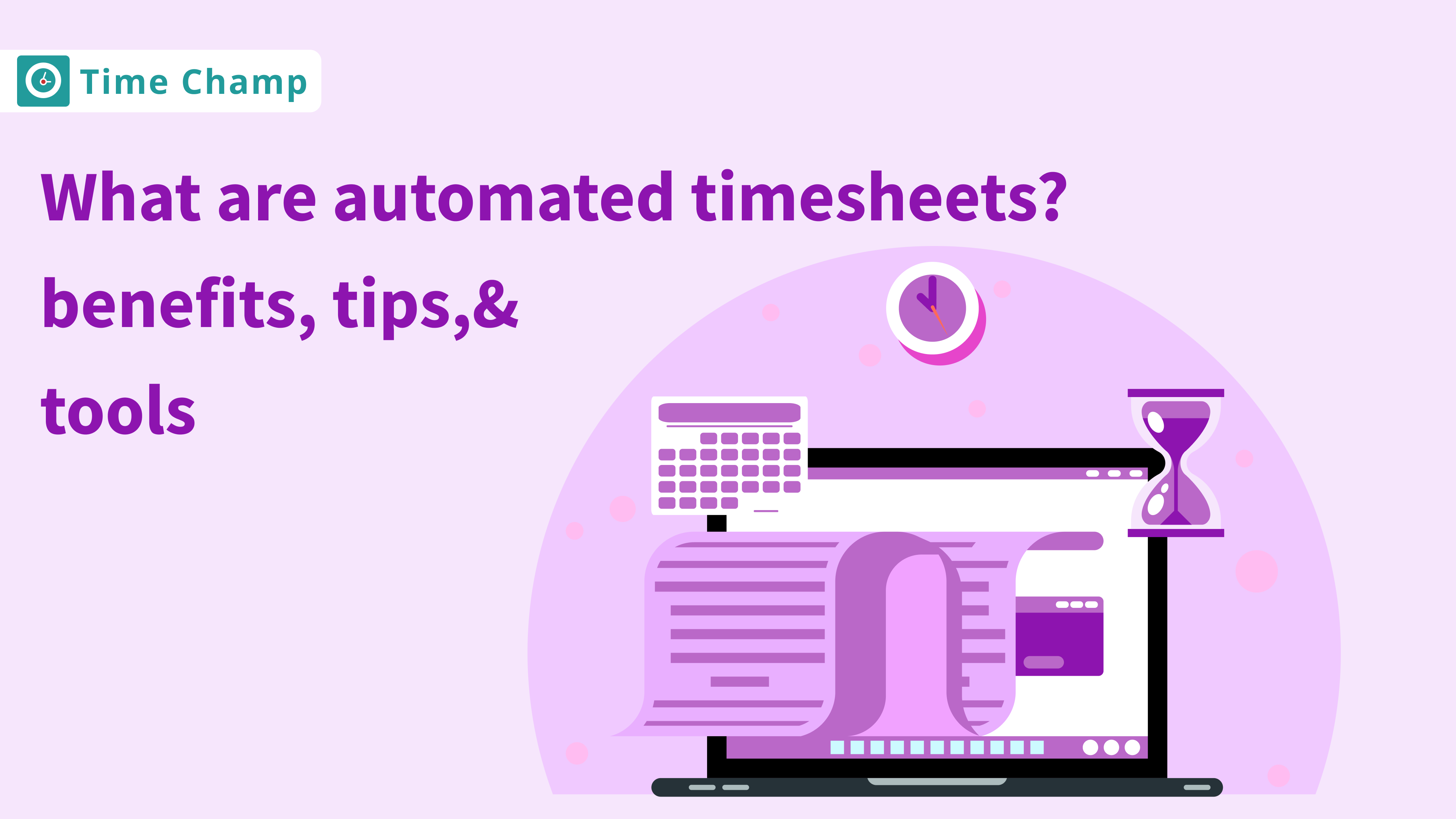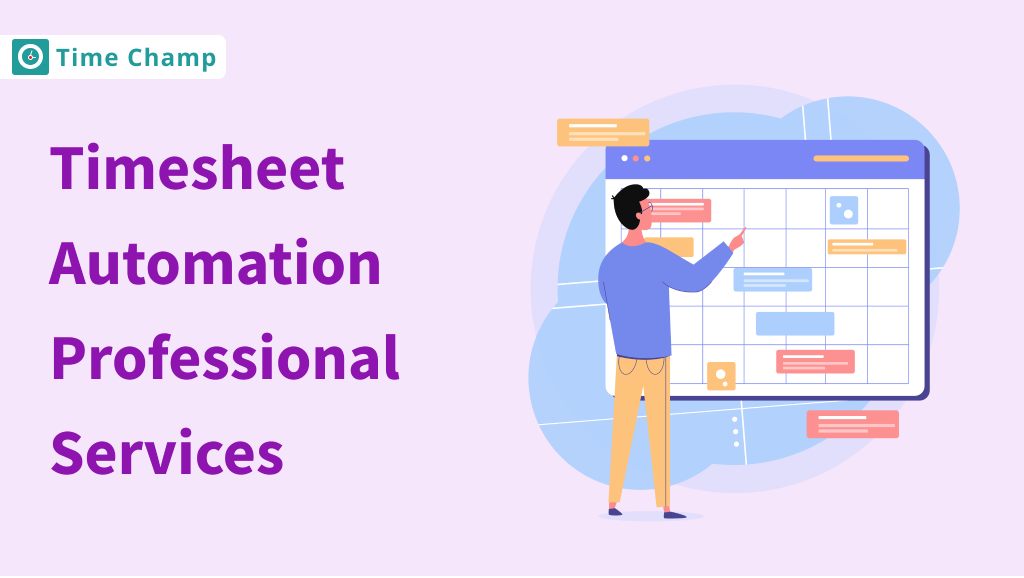In the last few years, digital transformation has made inroads into the world of business and modernized employees’ work hours. Replacing clock-ins with timesheets. Automation provides several benefits to employees and employers.
There is a need to track and control working hours by every company. They range from payroll to pricing, legal systems, and human resources. Still, there are easier ways to complete this easy but time-consuming task. But those days of manual entry are long gone. Companies prefer automated timesheet systems because it is convenient for employees to record the amount of time they spend at work.
What are Automated Timesheets?
Digital technologies including automated timesheet software, are used to register actual working time and specific tasks or projects.
It is therefore an upgrade from the typical manual system of logging work hours, which is done through the use of either paper-based timesheets or spreadsheets, where errors may be common, and the process can be quite time-consuming.
The Functionality of Automated Timesheet Systems
Automation makes timesheet software systems work with high accuracy and stability. It can host various devices and run systems that allow employees to clock in and out even when away from the office. With the new methods that include GPS tracking, biometric verification, and project tracking, you may be able to achieve more precision and detail compared to the old approaches.
Automatic Timesheet’s Role in the Workplace
All the time, automatic timesheets have two distinct roles in the workplace. It is an accounting tool and a resource management information system. With this real-time information concerning the operation patterns among the employees, the managers can see the performance, project execution, and the use of resources in such an aggregate that they can address inefficiency.
Computing, which uses an automated timesheet software system, may therefore not be simply a move from one method to another but growing up as an organization, entering the computer age. These systems integrate with other important business processes which include accounting, payroll,HR, and project management.
How Do Timesheets Work in Practice?
Punching the clock means a day’s start and stop for an employee. These dates are loaded into the automated time-tracking software that calculates the number of hours worked. Other systems can register time spent on certain actions or assignments and consequently provide clients with specific information on billing and performance assessment.
It should be mentioned that there are various automated timesheet software programs, each with its own set of features. Consider your business’s specific needs to pick the right system as it can range from simple time tracking to advanced project management integration features.
Now while we are focusing on the advantages and useful hints for the adoption of automated timesheets remember the technical jump they are. Not only technology but we are also talking about a door to improved business data, efficiency, and employee happiness.
Time Champ is an efficient tool to make work-time tracking and management much easier
Why Should You Avoid Traditional Time Tracking Methods?
With the modern trend toward efficiency and precision, the demise of old-style time-tracking systems has become inevitable. Now let’s take a closer look at why such older systems would be of more harm than help in today’s modern businesses.
Labor-Intensive Processes:
But most traditional time-tracking systems require a great deal of manual entry, which means more hours to be spent by employees and HR personnel on administrative work. Time could be better spent on core business activities that promote growth and innovation.
Actions prone to error and time-wasting:
However, according to human timekeeping, the inescapable influence of subjective guesswork results in errors and omissions. Apart from errors, paper-based systems are also vulnerable to time theft by people who falsify their hours, directly or indirectly.
Lack of Real-time Data:
Older methods have frequently been unable to provide timely information about workforce productivity. Managers and business owners may not look through the timesheet’s login until the end of a pay period, rendering it impossible to respond promptly to the information.
Difficulty in Compliance and Auditing:
Labor law compliance is no laughing matter, and with manual timesheets, it would be hard to assure adherence. Such automated timesheet software systems provide an unchangeable work log, which comes in handy when being evaluated by government auditors or inspectors.
Inefficiency in Payroll Processing:
Traditional payroll systems rely on manual data entry, which is prone to error and calls for extra checks. By contrast, automated timesheet software can be filed directly from the payroll software itself; there’s less scope for error and much less work involved in fixing it.
The Shift from Analog to Digital:
This process of moving from traditional to automated time tracking is a small piece of a larger pie affecting all companies that are going digital. By embracing digital solutions, you can take advantage of the advantages of accuracy, transparency, and analytics.
Timekeeping mechanization not only records activities: it promotes data-based management of work hours to help businesses achieve their potential and promote an ethic of responsibility and trust.
Top 5 Benefits of Timesheet Automation.
Timesheet automation not only easily solves many of the problems with conventional timesheet software, but also offers significant benefits to an organization. Here’s an in-depth look at the key benefits:
1. Streamlining of Business Operations:
Nothing beats automated timesheets Most will include integration with other business systems, providing a smooth transition from timekeeping to payroll processing, billing, and reporting. This interconnectivity helps improve operational efficiency and streamline management procedures.
2. Enhanced Analytical Insights:
However, most automated systems have some kind of analysis capacity that enables management to see exactly how time is spent by employees, this information can indicate productivity trends, support workforce planning, and even assist with fine-tuning project schedules and costs.
3. Improved Accuracy and Consistency:
The greatest benefit is the considerable reduction in error. Timesheet software controlled by a computer can easily record the exact time taken to complete tasks, making human error virtually disappear. In the long run, this robustness of data ensures that records become more and more accurate so that they record faithfully what happens in the workplace.
4. Enhanced Productivity and Resource Allocation:
Real-time tracking provides this granular insight, and revealing where employees are spending their time, helps managers to move around tasks that have become bottlenecks. The convenience of immediately available time-related information leads to timely interventions, allowing for higher overall efficiency.
5. Automated Payroll Integration:
Automated timesheets make payroll processing smooth and simple. The system automatically links work hours with payroll software, a convenient and accurate way of doing things. It also makes complying with wage and hour laws much easier, as all that’s needed is for the software to be adjusted accordingly.
Implementing automated timesheets is just one step toward a more nimble and adaptive business model. You can empower your organization and save administrative manpower by providing it with accurate data, to unleash potential for growth and innovation.
How to set up Automated Timesheet Software
This is an easy implementation that will radically reduce the amount of work needed on your payrolls and your project management.
Step 1: Choose an Automated Timesheet Software
Choose the best timesheet software automation applications based on the size and nature of your business. Look for advanced features, including live tracking, ease of use, and integration with the complexity of your undertakings. But things like scalability, seamless integration of other HR systems, and powerful reporting must have a big impact on your choice.
Step 2: Configure the Software.
Once you select an employee timesheet software, customize it according to the needs of your organization. This may involve setting up projects and tasks, setting working hours, and configuring approval workflows. This software is configurable, and compliance with your procedural systems in both areas of operation and HRMS is assured.
Step 3: Train employees on how to use the Software.
One major step is training your employees how to work with the timesheet software system. Ensure that they know how to enter hours worked, prepare reports, and pull up timesheet records. Training makes the transition from manual to automated tracking easier.
Step 4: Monitor the System and Make Adjustments as Needed.
When the timesheet software is deployed, watch the system and fine-tune it if necessary. One should monitor its implementation into the operational procedure to ensure that the required changes take place to enhance efficiency and simplicity.
Time Champ-The Best Timesheet Automation Tool
Time Champ is a formidable friend for any organization looking to switch to automated sheeting. But first, let’s explore what is unique about Time Champ and how it fits into the field of automation.
A Suite of Powerful Features:
One of the tools provided by Time Champ is automated timesheet software, which can help effectively manage a flexible and variable workforce. Project management integration, coupled with accurate tracking of time uses, also gives users a link to see how they are working. This information is helpful in accurate client billing and performance comparison.
When thinking about incorporating automated timesheets, don’t forget to look at Time Champ a complete time tracking software. Not only does it simplify time tracking; but more importantly, its powerful analytical and reporting tools provide a basis for better strategic decision-making.
- Seamless Integration: Time Champ is designed to seamlessly integrate with your existing environment, integrating with project management systems, communication channels, and financial applications into one united whole.
- User-Friendly Interface: In addition to this formidable functionality, Time Champ also has a user interface that is simple and easy for employees at all levels to use. Such a degree of ease of use is essential for achieving high adoption levels throughout the company.
- Robust Support and Customization: As customer support is a core value of Time Champ’s service, if businesses feel that they still need an individualized solution to adapt the platform to their operational model, then Time Champ will assist.
- Data Security and Privacy: Your data is protected in recognizing the importance of employee privacy, Time Champ takes a proactive approach to make sure your sensitive information is well guarded.
4 Simple Tips for Implementing Automated Timesheets
Confronting an unfamiliar system can be challenging, in particular with important functions like timekeeping and payroll. The following are four simple guidelines that will help make the process of moving to automated timesheets go as smoothly and successfully as possible.
Tip 1: Choose the Right Automated Timesheets Tool.
First, you need to choose the right automated timesheet system. Ease of implementation Consider what features you need, such as whether compatible with your existing hardware or software, capability for integration and reporting, and scalability. In this phase, preparing detailed research and product demos can be worth the time spent.
Tip 2: Focus on Ease of Use.
You shouldn’t select a system that just makes people’s work more complex. High adoption rates are tied to user-friendliness. A difficult-to-use automated timesheet system will inevitably lead to resistance. Having an easy-to-use interface and simple operation, such as Time Champ is well designed to facilitate positive acceptance of the change by users.
Tip 3: Integrate with Existing Systems.
To ensure a successful transition to automation, your new timesheet software system will need to seamlessly fit in with your current business operations. Integration functions combine with project management, payroll, HR software, and other key systems in the enterprise to reduce redundant data entry and provide for continuous updating of information.
Tip 4: Educate and Train Your Team.
We say that change management is not simply a matter of technology but also concerns people. The key to the successful introduction of an automated timesheet software system is letting them understand how it will save them time. Global training can be comprehensive, and instruction manuals are easy to follow; ongoing support helps lower resistance. As staff become accustomed to it, they will realize the improvements in their work processes and the company’s overall efficiency.
Past and Future of Automated Timesheets
Automated timesheets have advanced from the early days when punch clocks and paper were commonplace. The evolution of timesheet software has been in line with technological advancements from simple e-sheets to sophisticated, cloud-based, multi-integration compatible with other HRMS solutions.
The Past:
On the other hand, traditionally the timesheets were largely manual and that often led to mistakes, inefficiencies, and often time-consuming for the employees and the companies’ payroll staff. The first digital timesheets were a big step forward with the coming of the digital age, although they did not bring in automation for all processes nor was there the live interdependency present in today’s systems.
The Future:
Speaking of prospects, the opportunities for timesheet management seem to be bright as the leading timesheet software will adopt artificial intelligence and complex analytics to provide deeper and more powerful insights about their employees. AI-powered tracking and predictive time allocation features in such future timesheet software HRMS will assure increased accuracy and consistency. The application of all these technologies will yield an even more seamless and passive approach to business for all the stakeholders, resulting in a lower amount of operating costs, and opening up data-driven approaches to advancing the vision of an organization.
As companies increasingly adopt more agile work structures like remote and hybrid work, the need for advanced timesheet solutions that offer flexibility and complex features will continue. Programs such as Time Champ pave the way, limiting which is challenged since it is not only a functional component of business, but one of the best instruments to improve performance, but workforce management.
Conclusion
Making the transition from haphazard time tracking to an automated system is a big jump, but one which business must make to keep their competitive edge. Automated timesheet software automates complex operations, reduces opportunities for error, and allows time to be spent on value-added tasks.
Time Champ is unique in its approach, providing an all-around solution to time-tracking problems. With its sturdy features and user-oriented interface, it is a valuable tool to businesses for accuracy, efficiency, and gaining insight into their operations.
With these points in mind, organizations will find their transition to the automated timesheet software system proceed much more smoothly. Ultimately it should bring them better efficiency, greater accuracy, and a clear insight into business operations. Through the adoption of these cutting-edge systems, companies are taking leadership in innovation and operating efficiency.
Time Champ: The Time Champ As you weave your way through the intricate world of time tracking, think of us as your partner. With its complete set of features, it helps businesses attain their goals in a professional and refined way.
The road to a better and more efficient workplace is not far away. Learn to love the automated timesheet software and realize your workforce’s true potential.
Step into a culture of efficiency with Time Champ. Enjoy time-tracking automation designed just for you. Book a Time Champ Demo to see how you can maximize your team’s potential today.
FAQs on Automated Timesheets:
Automated timesheets are digital solutions that track and manage employees’ working hours automatically, reducing manual intervention and increasing accuracy.
Unlike manual tracking that relies on physical time cards or sheets, automated timesheets utilize software to record time, often with capabilities for real-time tracking and integration with other business systems.
Reputable automated timesheet systems have robust security measures in place to protect sensitive data and comply with privacy laws.
Automated systems help maintain detailed and accurate records of work hours, aiding compliance with labor and wage laws.




